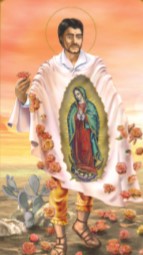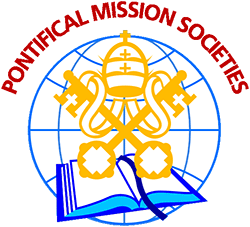Saint Juan Diego
Feast Day – December 9
Story and Activities for Saint Diego

Juan Diego was born in an area of Mexico that is just north of modern-day Mexico City. Historians describe him as a poor man—one that did not belong to the ruling or educated class. He was not, however, a slave or servant. Juan was known to be a hard worker. He owned a small piece of land on which he built a house and farmed. He also made mats out of local cactus fibers to support himself and his wife. When he was about 50 years old, he was baptized into the Catholic faith by one of the first Franciscan Missionaries to reach Mexico. He was given the Christian name Juan—Spanish for John. Juan was very devoted to his faith, and walked 14 miles several times a week to attend Mass.
Being a poor man, Juan walked barefoot, clothed in a cape, or tilma, made of fibers from the maguey cactus. This material is similar to rope and somewhat uncomfortable to wear; only the wealthy had access to cotton.
Juan Diego was born in an area of Mexico that is just north of modern-day Mexico City. Historians describe him as a poor man—one that did not belong to the ruling or educated class. He was not, however, a slave or servant. Juan was known to be a hard worker. He owned a small piece of land on which he built a house and farmed. He also made mats out of local cactus fibers to support himself and his wife. When he was about 50 years old, he was baptized into the Catholic faith by one of the first Franciscan Missionaries to reach Mexico. He was given the Christian name Juan—Spanish for John. Juan was very devoted to his faith, and walked 14 miles several times a week to attend Mass.
Being a poor man, Juan walked barefoot, clothed in a cape, or tilma, made of fibers from the maguey cactus. This material is similar to rope and somewhat uncomfortable to wear; only the wealthy had access to cotton.
It was during one of these walks that Juan first encountered a beautiful young woman dressed like an Aztec princess. She told Juan that she was the Virgin Mary and that she wanted a church to be built on the spot where they stood. She asked Juan to bring that message to his local Bishop [also named Juan], Most Reverend Juan de Zumarraga. Juan delivered the message but the Bishop was skeptical—why would the Blessed Mother appear to one so lowly? He asked for proof that it was truly Mary. As Juan was preparing to meet again with the beautiful Lady, he got word that his beloved uncle was gravely ill. He felt guilty for disobeying the Bishop but hurried to see his uncle, avoiding the route where he had met Mary. She found Juan as he traveled, assured him that his uncle was cured, and told him to go to the hillside to gather flowers in his tilma as proof of her true identity.
Juan gathered roses—flowers that never grew in that area—and presented them to the Bishop as a gift from Mary. As he opened his tilma and the flowers spilled out, everyone was amazed that the image of Mary herself was imprinted on his cloak. Juan’s tilma hangs to this day in the Basilica that was built as the Blessed Mother instructed.
Juan lived out his life in a hut built next to the church. He died at age 74 and was canonized in 2002. He was the first indigenous American saint.
